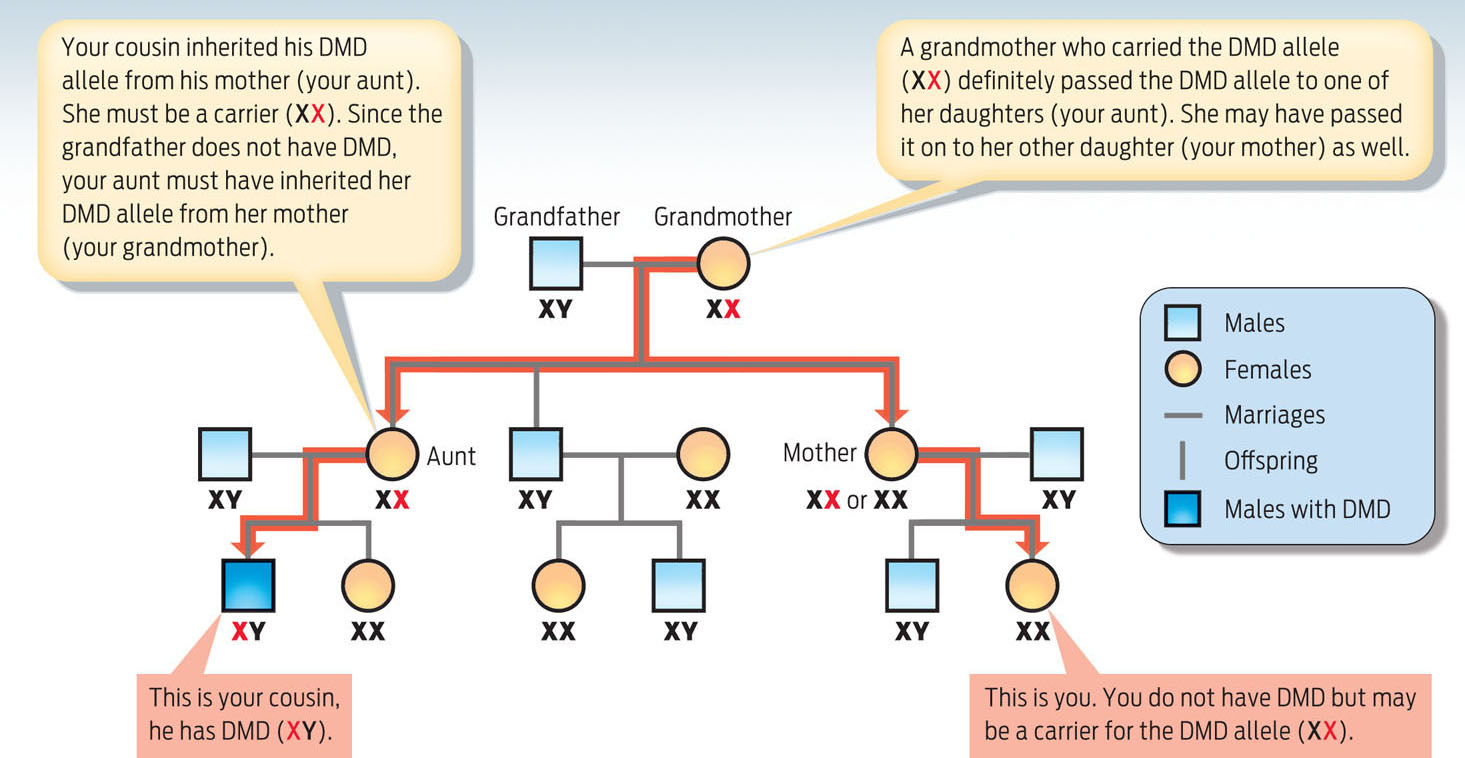Sex-Linked Inheritance
 Why do some genetic conditions affect sons more often than daughters?
Why do some genetic conditions affect sons more often than daughters?
ANSWER: Some 10 million American men—about 7% of the male population—either cannot distinguish red from green, or they perceive these hues differently from the way other people do. Such red-green color blindness affects only 0.4% of women. Similarly, 1 in 5,000 boys worldwide is born with hemophilia, a blood-clotting disorder, yet hemophilia rarely afflicts girls.
Why this disparity? These conditions are caused by genes found on the X chromosome. When a gene is located on either of the sex chromosomes, daughters and sons don’t share the same probability of inheriting it.
X-LINKED TRAIT A phenotype determined by an allele on an X chromosome.
Take the neuromuscular condition Duchenne muscular dystrophy (DMD), for example. DMD is a disease in which muscles slowly degenerate, leading to paralysis. About 1 in 2,400 boys worldwide is born with the condition each year. Most affected boys are in wheelchairs by the time they become teenagers, and they rarely live past 30.
Why does DMD primarily affect men? Recall that a female has two X chromosomes. For a recessive trait like DMD, a normal allele on one X chromosome masks the recessive disease allele on the other X chromosome. A male, on the other hand, has a single X chromosome, and will show the effects of any recessive alleles on that X chromosome. Because females can carry the disease allele without showing it, they may not even know they are carriers who can pass it on to their sons. Diseases and other traits such as DMD that are inherited on X chromosomes are called X-linked traits (INFOGRAPHIC 12.2) .
Duchenne muscular dystrophy (DMD) is an example of an X-linked trait. Recessive mutations of the dystrophin gene on the X chromosome cause the disease. DMD primarily affects males because they inherit only one copy of the X chromosome (from their mothers). Therefore, the single DMD allele they inherit determines their phenotype. Since females have two X chromosomes, they may carry the DMD allele but have a healthy phenotype.

So, for example, if you are female and DMD runs in your family—say, a male cousin has the disease—you could have inherited one DMD allele from your mother and not even know it. In this case, since your male cousin is affected, your aunt was a DMD carrier. Her son, your cousin, inherited her DMD-carrying X chromosome. Because males have only one X chromosome, your cousin doesn’t have another allele to mask his defective one, and therefore has the disease.
262
PEDIGREE A visual representation of the occurrence of phenotypes across generations.
Whether or not your sons will have the disease depends on whether or not you are a carrier, and on which X chromosome they inherit from you. Note that a woman always passes one of her two X chromosomes to each of her children, both sons and daughters. A man, on the other hand, passes his single X chromosome to his daughters and his Y chromosome to his sons. So if a male carries a disease allele on his X chromosome, he can’t pass it to his sons. He can, however, pass the disease allele to his daughters. If you are a DMD carrier, a son who inherits a DMD allele from you will have the disease. Your daughters who inherit your DMD allele will be carriers (assuming their father is healthy).
Because they receive only one X chromosome, boys have a higher probability of inheriting X-linked diseases than girls (though it is possible for girls to get them, too, but much more unlikely). By contrast, boys and girls share the same probability of developing diseases that, like cystic fibrosis, are carried on autosomes. This pattern is typical of rare X-linked traits, which pass down through generations to boys via their mothers and can be visualized on a pedigree, a visual representation of the occurrence of phenotypes across generations in a family (INFOGRAPHIC 12.3) .
The following diagram, known as a pedigree, shows how an X-linked trait (in this case Duchenne muscular dystrophy, or DMD) passes through generations.

263